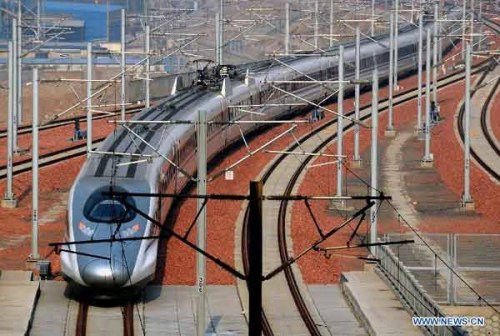
A bullet train from Guangzhou, capital of south China's Guandong Province, enters the Zhengzhou East Railway Station in Zhengzhou, capital of central China's Henan Province, Dec. 25, 2012. According to an announcement of the Ministry of Railways, the Beijing-Guangzhou high-speed railway, which links China's capital and Guangzhou, is expected to cut the travel time to about 8 hours from the current 20-odd hours by traditional lines. (Xinhua/Wang Song)
China's economy will be confronted with both opportunities and challenges in the year 2013, as the global economic situation is still full of variables.
Experts said that China should catch the strategic opportunity of transforming its growth pattern through expanding domestic demand, improving innovative capability and speeding up industrial upgrading to achieve quality development.
In addition, with China being a key driver of global growth, its successful growth model shift could have a significant impact on the rest of the world, they added.
Facing opportunities and challenges
An economic work conference held by China's central leadership not long ago pointed out that the global environment for the important period of china's strategic development opportunities has changed a lot
The opportunities China faces are not such traditional ones like integrating itself into global labor division system, expanding export and speeding up investment, but fresh ones of expanding domestic demand, improving innovative capacity and transforming its economic growth model.
As global economic prospects remain fragile and Europe's debt crisis lingers, external demand for China is unlikely to improve. However, this can also be an opportunity for the country to concentrate on economic growth quality and efficiency and the transformation of growth pattern.
"The global economy has entered a period of profound transition and correction from a period of fast growth in the pre-crisis years," the conference said, warning of rising protectionism and increasing pressure from potential inflation and asset bubbles.
Long Guoqiang from the development research center under the State Council said due to developed economies' slowdown, global investors will be more optimistic about China's economic prospects.
"Against this background, the middle and high-end resources worldwide are expected to be redistributed. By the time, the new trend of advanced industries shifting to China will emerge, thus creating a great opportunity for China's industrial structural transformation," Long said.
Zhang Qizuo, vice president of Chengdu University, held the contraction of external market leads to the reduction of China's export dividends and it has to expend domestic demand and innovate, which are new opportunities for development.
Zhang added that China is faced with a different period of strategic opportunities from that of the past. "As global economic growth points have been transferred from the developed country to the developing country, China's opportunities will also shift from focusing on both internal and external demands to giving priority to domestic demands."
Echoing Zhang's opinion, Lian Ping, chief economist at the Bank of Communication, noted that domestic demands will replace external demands as new opportunities for China's economic development.
Lian explained that with per capita GDP reaching a middle level and quick urbanization in the central and western areas, a window of new opportunities for China is opening up.
On the other side of the coin, the risks and challenges that China faces in economic development should never be overlooked, he added.
The central economic work conference indicated that the current unbalanced, uncoordinated and unsustainable development remains a big problem. In addition, the contradiction between economic downturn and production overcapacity has aggravated while problems of rising production cost and weak innovative capabilities exist.
Gao Peiyong, head of the Finance and Trade Economics Institute under the Chinese Academy of Social Sciences, held that slow global economic recovery, overcapacity and potential problems in financial field are the risks and challenges that China faces in the short term.
Guo Tianyong, researcher of the Central University of Finance and Economics, said the latest round of quantitative easing in the Unites States will result in the excess liquidity worldwide and this will in turn push up inflationary pressure next year.
Zhang Liqun, an analyst with the Development Research Center of the State Council, shared his view that as market supply and demand relations have changed, the rising costs of labor, resources and land have increased the pressure on unbalanced, uncoordinated and unsustainable development, thus posing challenge to China's sustainable and healthy economic development.

Copyright ©1999-2011 Chinanews.com. All rights reserved.
Reproduction in whole or in part without permission is prohibited.